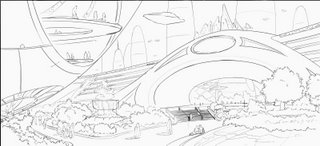City Gates: Line Drawing

Here's the fairly tight line drawing which is the next step in Syd Mead's process, after doing the grayscale value study. I left the file at 3000 pixels wide (it's reduced here to 800), but I used a pretty fat pencil tool in Painter and didn't zoom in too far to simulate drawing on a smallish piece of paper. Everything here is drawn by hand, with no guide curves or Bezier-path-generated ellipses.
It's actually not as hard as most people (and I used to) think to do smooth accurate curves (and ruler-straight lines, for that matter) by hand without tools or templates. The secret is twofold: speed, and use your whole arm - and of course, a lot of practice. But it's important to practice at speed to learn how to make smooth lines and curves. Pretty much everyone starts out trying to draw such things very slowly, sort of "petting" the line a small bit at a time. This just doesn't work at all, you get a rough or squiggly line; I tried it for years and of course had little success, and thus always fell back on rulers or templates.
This is probably one of the most important things I learned from Feng's class, from watching Feng draw: first, anyone can do this, so you can let yourself (if not force yourself) to believe that you can do it; second, just go ahead and do it a lot and practice and let your hand and arm learn how to do it, learn to trust your brain/nerves/muscles to do this action. It took maybe a couple of weeks of daily practice to get my first absolutely ruler-straight line drawn at an exact length... but after that, I knew I could do it and it ceased to be a problem. Same thing with curves and even ellipses (although I'm still a lot better at narrow ones than wider ones).
And of course, doing it digitally means you can make your curve, and if it's not right, hit Undo and do it again until it is right. But always try to make it right the first time, and you'll quickly find that you're hitting Undo less and less frequently - and your productivity explodes. :)
Anyway, so next I will attempt to imitate Mr. Mead's process for the "color miniature," a small-scale preliminary to figure out the colors of the final piece. I might wind up doing several different passes at it, just to see what happens.
Labels: portfolio

0 Comments:
Post a Comment
<< Home